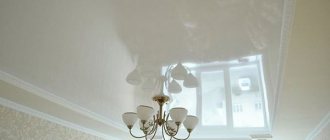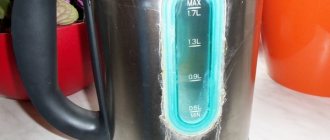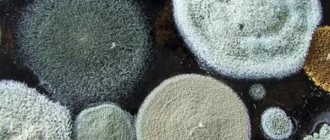What should installers fix?
The installation team provides a guarantee on the canvas and the quality of work, but not all cases fall under it. Sometimes repairs are required after a cut in the canvas due to the carelessness of the owners. Restoration work will have to be done at your own expense. In a warranty case, repairs are performed free of charge to the customer.
The main such situations are:
- the seam between individual fragments of the film diverges;
- the frame moved away from the wall;
- the film is not fixed in the baguette frame;
- the harpoon (lock with protrusions) comes out of the profile grooves.
The manufacturer is responsible for the strength of the seams; if they come apart, he must carry out repair work free of charge. But sometimes the canvas is damaged by crumbling plaster. Responsibility for such a defect lies with the persons performing the finishing work. If they were carried out by the owner, you will also have to repair the damage yourself.
Types of defects
Most damage can be repaired. But there are also serious defects; eliminating them is problematic, and sometimes even impossible. In this case, you will have to change the entire canvas. A common problem is seam splitting. This happens for a number of reasons:
- the cut was not sealed immediately, and it gradually enlarged;
- ceiling lamps, grilles and other elements were installed carelessly;
- there is no tread ring (fasteners to protect against film rupture);
- Low quality film was used.
These defects are eliminated as follows:
- you can trim uneven edges of the canvas;
- the harpoon is mounted on both sides of the canvas;
- The profile bar is installed on the edges of the canvas, bringing it to the level with the main frame;
- the film is well fixed in the baguette frame.
Small areas of seam divergence can be decorated with a special masking tape to match the stretch ceilings.
What are the dangers of using a stretch ceiling with a defect?
A hole or scratch may appear from accidental damage (careless use of tools during repairs, edges of furniture). A blunt object cannot seriously damage a suspended ceiling, much less make holes in it. But it’s enough to accidentally catch a seam when washing the ceiling, and you’ll have to spend money on repairing it.
Fabric canvas is stronger than PVC film, but it can also be damaged. A cut is a more dangerous defect than a through hole; over time, its area increases due to the tension of the film. A small cut can be quickly repaired, but if this is not done in a timely manner, it will leave a large hole.
Cases requiring professional intervention
There are also situations when you cannot do without specialists. Let's look at them in more detail.
Detachment of a profile (baguette) is usually the result of poor fastening or too much tension on the canvas. In the first case, the profile is reinstalled and the panel is tensioned, in the second, it will need to be redrawn and reinstalled. In both cases, work is carried out free of charge.
If a seam rupture occurs, the suspended ceiling must be replaced, also free of charge.
The sagging ceiling requires reupholstery. The cost depends on the cause of occurrence:
- aging ceiling;
- high temperatures;
- incorrect tension of the fabric.
A complete replacement of the panel will also be required if it is used in unheated rooms. Negative temperatures lead to the destruction of the film structure. If the size of the damage is more than 20 cm, specialists will not carry out repairs. In this situation, you will also need to replace the canvas.
Carefully read the contract and guarantees of the company you are going to cooperate with. Other repair services are no different from those that you can do yourself. With only one difference: if specialists do not only installation, but also repairs for you, the warranty on the ceiling structures remains intact.
How to choose a method based on the type of canvas
To repair a defect, you must first take into account the type of film (PVC, PS). The choice of repair method depends on the type of canvas. The following tools and auxiliary materials will be useful:
- ladder;
- sewing needles;
- heat hair dryer (for the plasticity of the canvas);
- paint roller with a long handle;
- thin rubber spatula;
- container for paint;
- ruler or tape measure, marker for basting.
Each material from which the canvas is made requires different materials, and the procedure is also different. The situation requires a special approach to remove the defect without a trace.
From fabric
This is a polyester fabric impregnated with a polymer composition. Synthetic fibers and natural threads are used for their production. The thickness of such a sheet usually does not exceed 0.37 mm. Fabric film is easier to repair - it stretches less and has a porous structure. Because of this, they are easy to repair and restore. It is necessary to change the entire sheet if the cut is more than 30 cm.
There are several ways to eliminate deficiencies on your own, depending on the type of ceiling. If the fabric option is installed, we can say that this is real luck. Small defects can be eliminated quite quickly and easily.
In the first option, you need to select threads to match (preferably from nylon) and sew up the hole with the edges inward. If the repaired area is very noticeable, it should be painted over with matte paint.
We recommend: How to securely secure an outdoor thermometer without damaging a plastic window?
The second option is to use a patch made of glass wallpaper or fabric. It is glued with colorless transparent glue. Then the area is treated with a spray gun with water-based paint.
PVC
The canvas is made from polyvinyl chloride, or more precisely, PVC fibers. This ceiling has a thickness of 0.17 - 0.22 mm and has good strength. PVC can withstand heat up to 100°C and melts at higher temperatures. Does not withstand sudden changes in heat, this may reduce strength.
This fabric is elastic and can be stretched if necessary. But don’t overdo it with this feature – it is easily deformed.
The location of the incision is important. The complexity of the repair depends on this. A small puncture can be repaired quite easily with special glue from a hardware store. This puncture is sealed and the appearance of the ceiling is completely restored. The cut requires more effort and has an increased level of difficulty, but there are still several options.
If the cut is a couple of centimeters from the wall, it can be easily repaired. To begin with, the damaged canvas is removed and a fragment is cut off. The white antenna cable is glued to the edge. When the glue hardens, you need to heat the canvas using a hair dryer for construction work, so the material will become pliable. Then push the open edge back into the fixing profile.
The second method is suitable if the canvas is torn closer to the central part of the ceiling. They put on a patch, for which the stretch ceiling scraps remaining after installation will come in handy. Cut out a fragment of suitable diameter and glue it over the hole with a composition suitable for PVC.
Ways to mask a hole
If a tear accidentally appears on the ceiling material, it must be strengthened along the edges. The torn fabric quickly diverges under its own weight. Masking tape or other flexible adhesive tape is suitable for this purpose.
Additional lamp
If a ceiling defect appears near a lighting fixture, there is a simple solution to mask it. The option is suitable for fastening with harpoons, but you will have to partially remove the structure and have some skills in handling electrics. The process itself looks like this:
- Partial dismantling is carried out at the place where the cut is located.
- A mortgage is attached to the ceilings at the place where the lamp is located.
- Then the wiring and connection to the network are laid, the canvas is fixed in its original place.
You need to glue a special thermal ring, cut out the film and get the electrical cable. You shouldn’t limit yourself to just one lamp; they can be arranged in a whole group.
Vent. hole or sensor
A diffuser is installed if the cut is in a corner. Its size should cover the length of the cut itself. The repair algorithm looks like this:
- Glue a plastic ring to the stretch ceiling fabric so that the defect is located inside it;
- if necessary, you need to trim the canvas itself;
- insert the grid.
This method is suitable for all ceiling materials and all types of fastenings. The diffuser provides additional air ventilation. In addition to the cut, sticking and sagging of the canvas can be eliminated.
If the hole is near the edge
The repair method is suitable for a structure made of film mounted on harpoons. But the distance between the hole and the wall should be no more than 15 cm. In this case, the ceiling is repaired as follows:
- partially remove the harpoon from the baguette where the damage is located;
- cut off the area with the hole;
- glue the edge to the main fabric in increments of several centimeters;
- heat the film with a hairdryer;
- cover the edge with a baguette frame.
It is permissible to trim the edge of the canvas with scissors. Vinyl film stretches well and if all manipulations are performed carefully, after repair the surface will look like new.
Glue
To repair a suspended ceiling, you will need a reliable composition that will fix the canvas and not damage it. These compositions are shown in the table:
| Type of glue | Description |
| Cosmofen | quick-setting adhesive, resistant to temperature loads, provides good strength and is completely safe for humans, environmentally friendly |
| Somafix | plastic composition, does not lose its properties when dried, sticks well, does not require degreasing the surface before application |
| Cosmoplast | the manufacturer of this composition produces a wide range of similar adhesives, but only three of them can be used to repair ceilings - these are 500, 500L, 513 |
| Adhesive Contact | glues PVC fabric well and firmly |
If the hole is 1-3 mm in size, it can be eliminated by generously moistening it with glue (blotting it with a brush or roller). This way the puncture will be completely invisible and will not increase in size.
Patch
This method can be used to repair small cuts. The easiest way is to attach it on top of the hole; to do this, you need to follow these steps:
- cut out a patch of the required size from the fabric so that the hole is completely covered by it;
- coat it with adhesive;
- attach to the ceiling;
- smooth out efficiently and tightly.
We recommend: Why does store-bought bread quickly become moldy and not stale?
If the patch color and glue are chosen correctly, the damage will not be noticeable. If possible, it is better to partially dismantle the ceiling and carry out cosmetic repairs from the inside.
Decor elements
If it is impossible to hide the patch, it can be turned into a decorative element. This will make the ceiling design more individual. Decor is sold in construction stores. You should carefully press the sticker onto the patch or hole (the hole should be smaller in diameter than the decorative element).
Types of glue for repairs
Regular glue is not suitable for sealing holes in vinyl material. For film or fabric, choose a product that meets the following requirements:
- transparency - using glue of a different color will lead to the formation of stains on the surface of the base, which will be very difficult to remove;
- drying speed - a quick-drying composition will eliminate the need to fix the patch and wait several hours;
- impact on the canvas - chemically active agents corrode the material, so it is better to choose one that will glue without destroying the base.
All these requirements are met by adhesive compositions made on the basis of cyanoacrylate:
- Craftsmen who install and repair suspended ceilings recommend using Cosmofen glue (Germany).
- For those who prefer plastic products, the SomaFix second gel (Turkey) is suitable. It forms an elastic film at the junction.
- Universal superglue Contact (Russia) is supplemented with a cleaner of the same brand, which facilitates repair work.
- Among Loctite (USA) adhesives for repairing ceiling materials, you can choose Loctite 404 or 401. They are designed specifically for smooth surfaces that are difficult to glue.
- Cosmoplast (Germany) is similar in characteristics to Cosmofen. Types 500 and 500L form a tough, durable film at the tear site. Type 513 forms an elastic layer after drying.
All adhesives are used in a well-ventilated room. It is necessary to avoid contact with the skin and mucous membranes, and in case of contact, rinse with plenty of water.
Instagram @nextlevel_potolki
Major damage cannot be repaired on your own. In such situations, it is better to seek help from specialists.
Water breaks
When flooded, a suspended ceiling can withstand a large volume of water. The fabric itself ensures tightness. PVC stretches better than fabric and is able to retain water, thereby insuring the safety of the apartment’s finishing.
To drain the water, you need to make several punctures - one in the center of the formed “drop”, the second - where there is no water. They can be made with an awl or a thick needle. If there is not much water, the material will return to its original shape after draining the water.
A fabric ceiling can tear due to a large volume of water, since such material has less stretch than its PVC counterparts. Also, after water there will be stains on the surface that can be removed with paint.
Professional restoration
In some cases, it will simply be pointless to undertake repairs to a suspended ceiling. These include cases when the seam diverges or a hole larger than 200 millimeters appears. In the second case, even attaching a patch or application material will not help in any way; the hole under tension will diverge much further. That is why replacing the ceiling fabric cannot be avoided. If the seam comes apart, then you won’t be able to glue it yourself, so you will need to completely replace the canvas, since organizations that install ceilings will not glue old canvases.
Of course, everyone hates when an unattractive hole appears in their ceiling. Not all defects can be eliminated on your own; you need to listen to the opinion of a specialist. When ordering suspended ceilings, you should pay more attention to the reputation of the company, the materials it uses, and warranty periods. In the future, this will help reduce the risk of poor-quality ceiling finishing in your home.
Useful tips
To extend the life of the ceiling, there are some recommendations:
- Before fixing the patch, you need to degrease the surface locally to improve the properties of the glue;
- use special sprays, dish soap, non-aggressive detergents to wash the ceiling;
- it is necessary to take all necessary measures immediately after discovering a defect so that the incision does not expand;
- if the image is damaged, you will have to replace it with a new design or additionally decorate this place;
- Before carrying out repairs, you must make sure that the cut is not caused by a manufacturing defect or installation defect (if so, the repair will be carried out under warranty).
A company employee will carry out all necessary repairs and provide a warranty period for them. Rupture of seams can be done without replacing the entire ceiling; more often, this requires minor cosmetic repairs. Owners repair mechanical damage caused by the owners at their own expense.
Precautions to maintain the integrity of the stretch ceiling
Often repairs are required within the first week after installation, since the canvas has not yet shrinked and is under overload. But usually damage occurs due to improper installation. In this case, you will have to resolder the fabric using special equipment from the manufacturer.
The most common causes of damage are the following:
- careless games of children with plastic arrows, radio-controlled toys;
- installation of tall furniture, for example, a wardrobe;
- temperature changes, since during installation the canvas heats up; if the window is opened after this, the canvas may be damaged;
- defects made during the production process.
It is not recommended to repair breaks near walls. To do this, it is better to call a specialized team of workers who have the necessary skills, knowledge and equipment.
Causes of damage
Tears or punctures can appear quite often. They happen for various reasons. The most common ones include:
- Unscrupulous installation - too much tension in the material, a poorly secured profile, or unsuccessful insertion of built-in lamps in unacceptable proximity to the seam.
- Toys or other objects thrown too high are dangerous due to sharp or jagged parts.
- Rearranging tall furniture with protruding corners.
- Installation of curtain rods - carelessness of the master can lead to tearing of the fabric.
- Poor quality welding of the seam of the panel - when stretched, the film breaks.
It is important not to delay the repair: the stretched surface will continue to spread due to its own stretching. Therefore, immediately after discovering a cut, you need to seal its edges with masking or double-sided tape.










